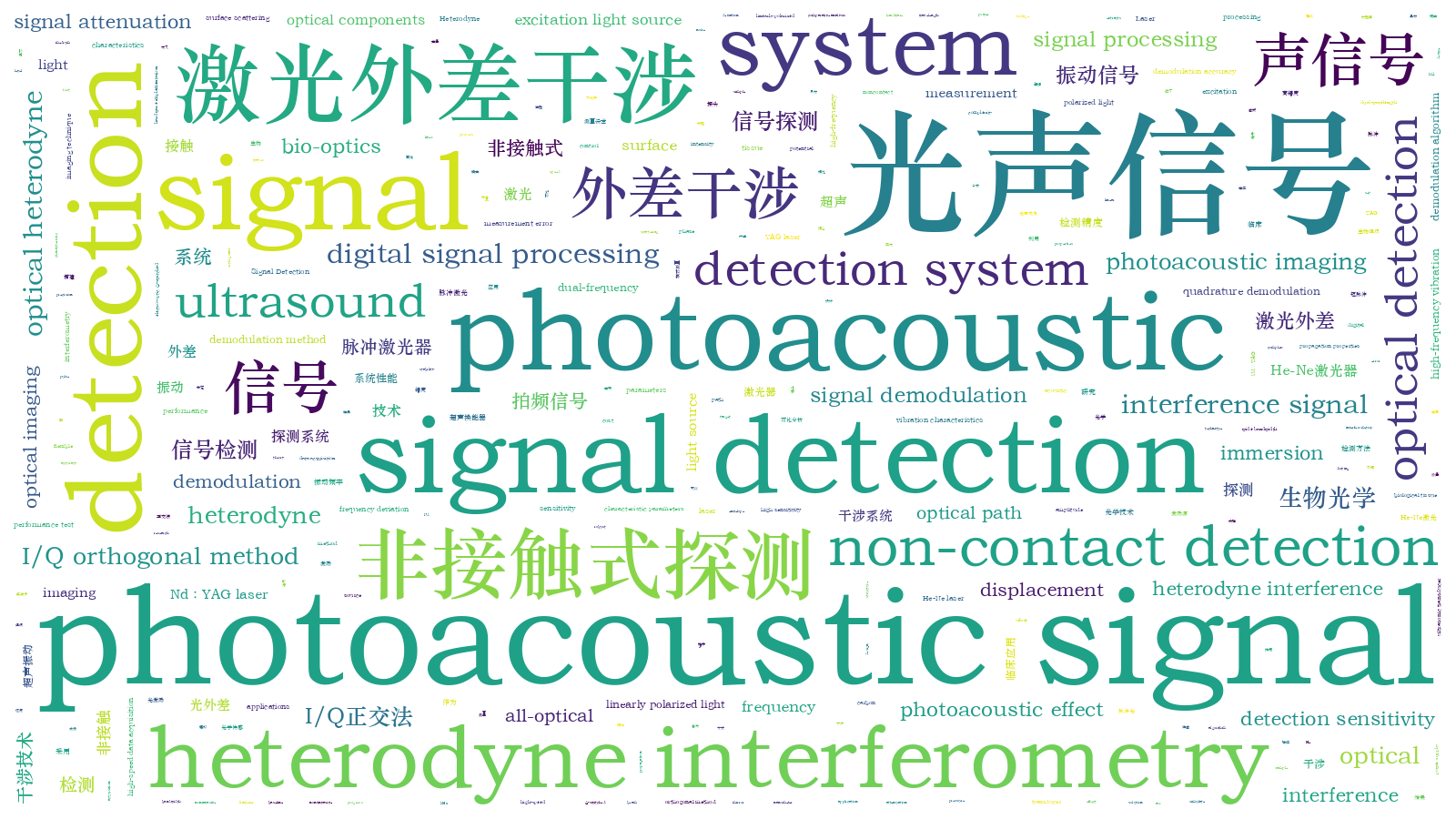基于激光外差干涉技术的非接触式光声信号检测研究【增强内容出版】
Photoacoustic imaging is a non-invasive, functional optical imaging technique that uses the photoacoustic effect with ultrasound as a mediator. Despite its potential for various medical applications, traditional contact-based signal detection methods have hindered its progress in clinical practice. To overcome these limitations, non-contact detection of photoacoustic signals has emerged as a solution. This approach uses air-coupled or all-optical detection methods and achieves a wide bandwidth and high sensitivity for ultrasound signal reception, aligning with the demands of modern medical technology. Current contact-based photoacoustic imaging still faces challenges, such as signal attenuation, surface scattering, system sensitivity, and environmental interference. Therefore, in this study, a noncontact, noninvasive, and cost-effective photoacoustic signal detection device, based on the optical heterodyne technology, is proposed. We aim to address the challenges in photoacoustic signal detection, reduce system costs and complexity, and promote the practical application of non-contact photoacoustic imaging in clinical settings.
The photoacoustic signals are detected using heterodyne interferometry. First, based on the characteristic parameters of tissue surface vibration signals and the propagation properties of ultrasound waves in a medium, the relationship between the vibration displacement and pressure causing the vibrations is established. Subsequently, by employing the dual-frequency optical heterodyne interferometric theory, the relationship between the photoacoustic signal-induced tissue surface vibration displacement and phase changes is established. Furthermore, I/Q quadrature demodulation is applied to process the photoacoustic signals; this ensures system stability and high demodulation accuracy in complex environments. To achieve all-optical detection of photoacoustic signals, an photoacoustic signal detection system is designed using a He-Ne laser as the detection light source. The optical components are configured to construct an optical-path system for precise detection of photoacoustic signals. In the experiments, an electro-optic Q-switched dual-wavelength Nd∶YAG laser is selected as the excitation light source. This laser allows for flexible control of the excitation light conditions by adjusting the beam diameter and intensity. Finally, the acoustic vibration characteristics induced in the sample under stimulation are evaluated by observing the phase changes and vibration displacement of the photoacoustic signals.
In this study, we investigate the detection of ultrasound vibrations generated by an ultrasound transducer (UST) using a photoacoustic signal full-optical detection system and an immersion probe. A comparative analysis of the measurement results reveals that the heterodyne interference system effectively reconstructs the ultrasound vibrations. The demodulated ultrasound displacement pulse envelope is closely aligned with the measurement result obtained using the immersion probe (Figs.3 and 4). Under constant input parameters, varying the amplitude of the power supply voltage results in a linear increase in the ultrasound signal intensity, which is measured by both the heterodyne system and immersion probe (Fig.5). Furthermore, different driving frequencies are set with constant input signal parameters. The ultrasound vibration frequencies measured by our system and the immersion probe are comparatively analyzed. According to the analysis results, the I/Q quadrature demodulation method accurately extracts ultrasound vibration frequencies with minimal relative measurement error, exhibiting an absolute difference of 0.2 kHz (Table 1). In the absence of excitation pulses, the demodulated baseline interference signal displays subtle displacement deviations with displacement offset control at the nanometer level (Fig.8). The detection of ultrasound vibrations on the surface of a carbon rod demonstrates a close agreement between the ultrasound vibration frequencies demodulated by our system and those measured by the immersion probe (Figs.6 and 7). However, in the case of ultrasound detection on the surface of the porcine liver, the rigidity of measurement mirror M2 leads to higher-frequency vibrations demodulated by our system compared to those measured by the immersion probe (Figs.9 and 10).
In this study, optical heterodyne interferometry and digital Doppler signal demodulation methods are used to experimentally investigate non-contact photoacoustic signal detection. The acoustic vibration characteristics of the target are extracted through the demodulation of the dual-frequency optical heterodyne interference signals. Subsequently, an ultrasonic transducer is employed to simulate the high-frequency vibration signals, and a performance test is conducted. The experimental results demonstrate that the heterodyne system effectively reconstructs photoacoustic vibration signals with minimal relative frequency deviation compared to the immersion probe. In addition, experiments involving a carbon rod and excised biological tissue reveal that the heterodyne system based on the I/Q orthogonal method exhibits superior performance in demodulating photoacoustic signals owing to its insensitivity to changes in the interference signal amplitude. Moreover, the designed photoacoustic signal detection system incorporates linearly polarized light and heterodyne interferometry and the detection sensitivity and precision are enhanced. The heterodyne optical path structure, which is easily adjustable and effective in suppressing interference noise, contributes to the robust performance of the system. By utilizing high-speed data acquisition cards and digital signal processing techniques for interference signal processing, the demodulation algorithm proves to be simple and flexible in design, offering potential cost savings in hardware implementation. The research findings suggest that the proposed system holds a certain reference value for clinical applications in noncontact photoacoustic signal detection.
王成, 梁宸, 皇甫胜男, 朱俊, 张瑶, 徐锦程, 郑刚, 项华中, 张大伟. 基于激光外差干涉技术的非接触式光声信号检测研究[J]. 中国激光, 2024, 51(3): 0307402. Cheng Wang, Chen Liang, Shengnan Huangfu, Jun Zhu, Yao Zhang, Jincheng Xu, Gang Zheng, Huazhong Xiang, Dawei Zhang. Research on Non‑contact Photoacoustic Signal Detection Based on Laser Heterodyne Interferometry[J]. Chinese Journal of Lasers, 2024, 51(3): 0307402.







